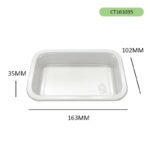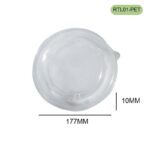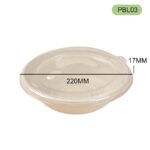Quick Summary
Compostable lunch boxes are revolutionizing the way we think about food packaging. Made from plant-based materials such as bagasse, cornstarch, and PLA, these containers are fully biodegradable, compostable, and environmentally friendly. Ideal for restaurants, takeout services, schools, and home use, eco-friendly lunch boxes reduce plastic waste, support a circular economy, and promote sustainable dining practices without compromising convenience or functionality.
Introduction: Why Lunch Boxes Matter for Sustainability
Single-use plastic has long dominated food packaging, from takeaway containers to cafeteria trays. While convenient, traditional plastic contributes significantly to global pollution. Millions of tons of plastic end up in landfills, rivers, and oceans each year, breaking down into microplastics that threaten wildlife, ecosystems, and human health.
With rising environmental awareness, governments, businesses, and consumers are seeking alternatives that reduce the ecological footprint of daily life. Compostable lunch boxes have emerged as a practical, scalable solution. Not only do they replace plastic, but they also align with the principles of circular economy, turning renewable resources into functional packaging and eventually back into natural soil-enriching material.
Materials Behind Eco-Friendly Lunch Boxes
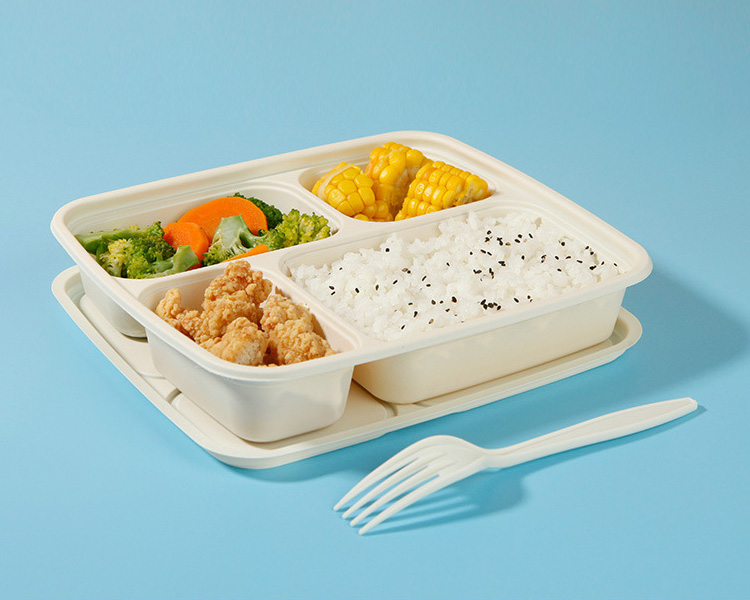
Modern compostable lunch boxes are crafted from renewable plant-based materials, providing durability while minimizing environmental impact. Some of the most common materials include:
1. Bagasse
Bagasse is the fibrous residue left after sugarcane juice is extracted. Traditionally treated as waste, bagasse is now molded into biodegradable trays, bowls, and clamshell containers. It is fully compostable, heat-resistant, and water-repellent, making it ideal for hot and cold foods.
2. Cornstarch
Cornstarch-based lunch boxes are derived from fermented corn sugars. Lightweight and biodegradable, these containers can decompose in industrial or home composting systems. They are especially suited for cold or room-temperature meals but may be enhanced with coatings for added heat and moisture resistance.
3. PLA (Polylactic Acid)
PLA is a bioplastic produced from fermented plant sugars, usually corn or sugarcane. PLA containers are biodegradable under industrial composting conditions and are suitable for a variety of foods. Heat-resistant variants, such as CPLA (Crystallized PLA), can handle hot dishes, soups, and sauces.
4. Other Materials
Some lunch boxes are made from wheat straw, palm leaves, or bamboo fibers. These materials are reusable or compostable at home, offering additional eco-friendly options for both consumers and businesses.
Key Advantages of Compostable Lunch Boxes
Eco-friendly lunch boxes offer multiple benefits that make them an attractive alternative to traditional plastic containers.
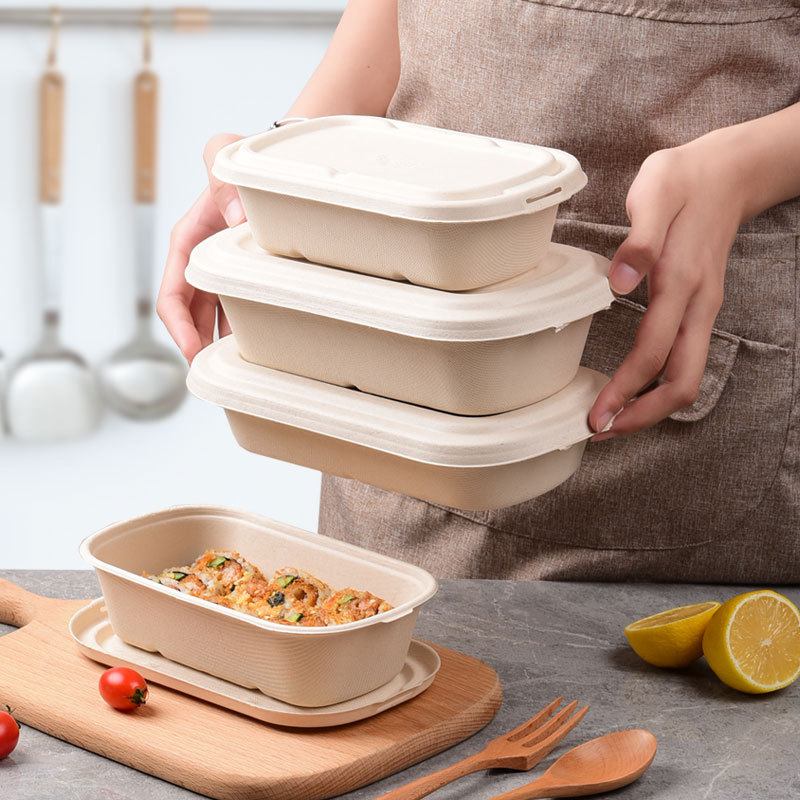
Environmental Impact
-
Biodegradability and Compostability: Properly disposed of compostable lunch boxes break down into nutrient-rich organic matter in 60–180 days, depending on material and composting conditions.
-
Reduction in Plastic Pollution: By replacing single-use plastics, these containers help prevent the accumulation of long-lasting plastic waste in landfills and oceans.
-
Circular Economy Support: Plant-based lunch boxes turn agricultural byproducts into usable products and eventually back into soil, reducing the demand for virgin resources.
-
Lower Carbon Footprint: Producing compostable lunch boxes generally emits less greenhouse gases compared to petroleum-based plastics.
Practical Performance
-
Durability: Modern plant-based lunch boxes are sturdy enough to carry sauces, hot meals, and snacks without leaking or warping.
-
Heat and Moisture Resistance: Bagasse and CPLA containers can withstand microwaving and hot foods. Coatings such as PLA or wax enhance moisture protection while remaining compostable.
-
Lightweight & Convenient: Eco-friendly lunch boxes are easy to transport and handle, suitable for food delivery, takeout, or school lunches.
Health and Safety
Compostable lunch boxes are free from harmful chemicals like BPA, PFAS, and heavy metals. They meet international standards, including FDA and EU food contact regulations, ensuring safe use for hot and cold meals.
Real-World Applications
Eco-friendly lunch boxes are being widely adopted across multiple industries and settings.
Restaurants & Cafés
Restaurants use compostable containers to serve takeout meals, combining convenience with eco-conscious branding. Customers increasingly prefer businesses that reduce plastic waste, creating both environmental and reputational benefits.
Catering & Events
Catering services at weddings, corporate functions, and festivals benefit from biodegradable lunch boxes that simplify cleanup and reduce landfill contributions. Multi-compartment designs keep different dishes separate while maintaining a high-quality presentation.
Educational Institutions
Schools and universities implement compostable lunch boxes to promote sustainable habits among students. Integration with composting programs provides hands-on environmental education, helping the next generation understand waste management and circular economy principles.
Corporate and Office Use
Many companies provide compostable containers for employee lunches, reducing plastic waste generated by daily meals. This supports corporate sustainability initiatives and encourages eco-conscious behavior in the workplace.
Takeout and Delivery
Food delivery services increasingly rely on plant-based lunch boxes to maintain food quality while offering environmentally responsible packaging. Water- and oil-resistant designs ensure meals arrive intact, and customers appreciate the sustainable choice.
Case Studies
1. Urban Cafés in Tokyo
A chain of cafés replaced all traditional plastic lunch boxes with bagasse-based containers across 10 locations. Within six months:
-
Single-use plastic usage dropped by 40%.
-
Customer surveys indicated increased satisfaction and loyalty.
-
Social media campaigns highlighting sustainability improved online engagement by 25%.
2. University Cafeterias in Canada
A major university implemented cornstarch and PLA lunch boxes in all dining halls. Results:
-
35% reduction in plastic waste.
-
Integration with on-campus composting allowed students to directly witness decomposition.
-
Sustainability programs saw higher participation due to visible environmental impact.
3. Corporate Catering in Germany
A multinational company switched to CPLA lunch boxes for all employee meals and corporate events. Outcomes:
-
Over 50,000 meals served in eco-friendly containers annually.
-
Reduced landfill-bound plastic by 45%.
-
Encouraged employees to adopt reusable containers and home composting.
Scientific Insights
Compostability and Biodegradation
Research shows that PLA, CPLA, and bagasse containers fully decompose in industrial composting environments within 30–180 days, depending on conditions. In contrast, conventional plastics may persist for hundreds of years, breaking into microplastics that contaminate soil and water.
Carbon Footprint Reduction
Studies indicate that producing plant-based containers generates up to 60% less greenhouse gas compared to petroleum-based plastics, due to renewable feedstocks and lower energy consumption.
Safety and Environmental Compliance
Compostable lunch boxes comply with regulations for direct food contact, are free from toxic chemicals, and do not release harmful residues when composted. Proper disposal ensures that soil quality is enhanced rather than degraded.
Tips for Effective Use and Disposal
-
Choose Certified Products: Look for ISO, BPI, TÜV, or OK Compost certifications.
-
Separate Waste Properly: Ensure lunch boxes are disposed of in home or industrial composting facilities rather than landfills.
-
Avoid Contaminants: Rinse or scrape off heavy oils or non-compostable materials before composting.
-
Educate Consumers: Provide guidance on disposal, both in restaurants and corporate settings, to maximize environmental benefits.
Future Trends
The market for eco-friendly lunch boxes is expanding, driven by consumer demand, environmental policies, and corporate responsibility programs. Innovations include:
-
Multi-compartment designs for varied meals and sauces.
-
Enhanced water and heat resistance without compromising compostability.
-
Integration with digital sustainability tracking for businesses to measure impact.
-
Custom branding options for restaurants and catering services, promoting eco-conscious practices.
Governments worldwide are also strengthening regulations on single-use plastics, creating incentives for businesses to adopt compostable alternatives.
Conclusion
Compostable lunch boxes represent a practical, effective, and responsible solution to the global plastic crisis. By combining environmental benefits, functional design, and safety, they meet the needs of restaurants, caterers, educational institutions, corporate offices, and consumers alike.
Choosing eco-friendly lunch boxes is not merely a trend—it is a tangible step toward a circular economy, reduced plastic pollution, and a more sustainable future. From casual meals to large-scale catering, compostable containers prove that convenience and environmental responsibility can go hand in hand.
Frequently Asked Questions (FAQ)
Q1: How long do compostable lunch boxes take to break down?
A1: Depending on material and composting conditions, they decompose within 30–180 days. Industrial composting accelerates the process, while home composting may take longer.
Q2: Are compostable lunch boxes microwave-safe?
A2: Bagasse and CPLA containers are microwave-safe up to ~220°F (104°C). Cornstarch lunch boxes are better suited for cold or room-temperature foods unless specially coated.
Q3: Can these containers handle liquids and oily foods?
A3: Yes, many containers are water- and oil-resistant, with coatings such as PLA or natural wax enhancing performance while remaining compostable.
Q4: Are compostable lunch boxes safe for children?
A4: Yes, they are free from BPA, PFAS, and heavy metals, making them safe for school lunches and family meals.
Q5: Where can I purchase eco-friendly lunch boxes?
A5: Available online, through wholesale suppliers for restaurants and catering, and from vendors offering custom-branded biodegradable containers.
References
-
NatureFlex Blog: The Benefits of Compostable Packaging for Businesses
NatureFlex -
Maadho: The Hidden Benefits of Compostable Food Containers for Businesses
Maadho -
Good Start Packaging: The Upstream Benefits of Compostable Packaging
goodstartpackaging.com -
Platinum Packaging Group: 5 Benefits of Compostable Trays
The Platinum Packaging Group -
Hotpack Webstore: Environmental Benefits of Compostable Food Packaging
hotpackwebstore.com
Copyright Statement
© 2025 Dashan Packing. All rights reserved.
This article is an original work created by the Dashan Packing editorial team.
All text, data, and images are the result of our independent research, industry experience,
and product development insights. Reproduction or redistribution of any part of this content
without written permission is strictly prohibited.
Dashan Packing is committed to providing accurate, evidence-based information and
to upholding transparency, originality, and compliance with global intellectual property standards.


